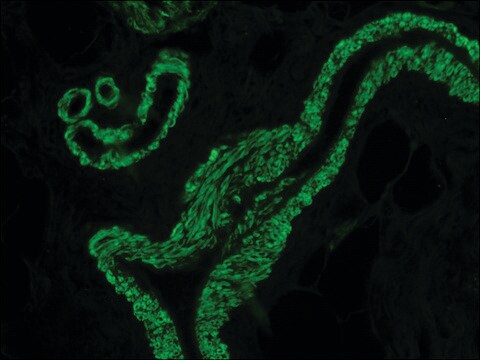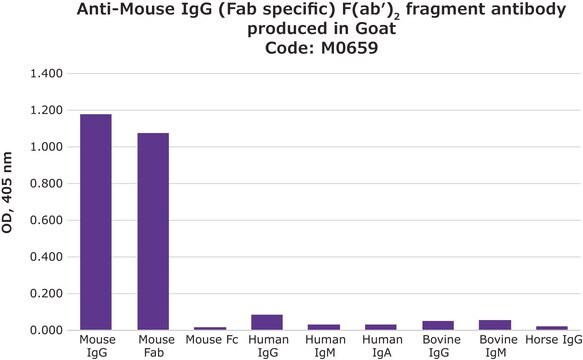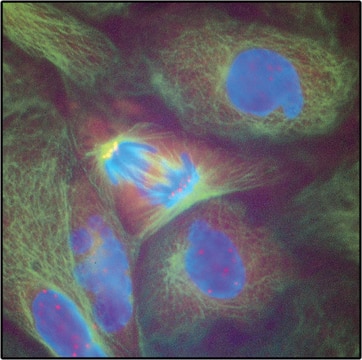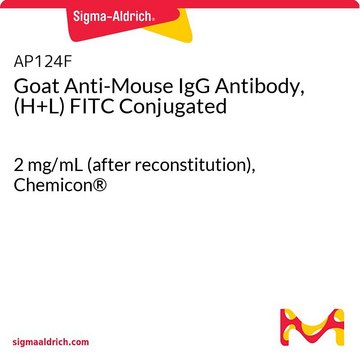F2772
Anti-Mouse IgG (Fc specific) F(ab′)2 fragment−FITC antibody produced in goat
flow cytometry grade, affinity isolated antibody, buffered aqueous solution
Sign Into View Organizational & Contract Pricing
All Photos(1)
About This Item
Recommended Products
biological source
goat
Quality Level
conjugate
FITC conjugate
antibody form
affinity isolated antibody
antibody product type
secondary antibodies
grade
flow cytometry grade
clone
polyclonal
form
buffered aqueous solution
storage condition
protect from light
technique(s)
flow cytometry: 1:100
immunohistochemistry (formalin-fixed, paraffin-embedded sections): 1:160
storage temp.
−20°C
target post-translational modification
unmodified
Looking for similar products? Visit Product Comparison Guide
General description
IgG antibody subtype is the most abundant serum immunoglobulins of the immune system. It is secreted by B cells and is found in blood and extracellular fluids.
Fluorescein isothiocyanate (FITC) is a fluorescein derivative (fluorochrome) used to tag antibodies, including secondary antibodies, for use in fluorescence-based assays and procedures. FITC excites at 495 nm and emits at 521 nm.
Fluorescein isothiocyanate (FITC) is a fluorescein derivative (fluorochrome) used to tag antibodies, including secondary antibodies, for use in fluorescence-based assays and procedures. FITC excites at 495 nm and emits at 521 nm.
Mouse IgG is a plasma B cell derived antibody isotype defined by its heavy chain. IgG is the most abundant antibody isotype found in mouse serum. IgG crosses the placental barrier, is a complement activator and binds to the Fc-receptors on phagocytic cells. The level of IgG may vary with the status of disease or infection.
Anti-mouse IgG is conjugated to Fluorescein Isothiocyanate (FITC), Isomer I. The F(ab′)2 antibodies isolated from goat antiserum by affinity chromatography, react specifically with mouse IgG Fc; does not bind other mouse Igs. No cross reaction is observed with mouse Fab fragment. The antibody shows minimal cross reaction with human, horse and bovine proteins on tissue or cell preparations.
Anti-mouse IgG is conjugated to Fluorescein Isothiocyanate (FITC), Isomer I. The F(ab′)2 antibodies isolated from goat antiserum by affinity chromatography, react specifically with mouse IgG Fc; does not bind other mouse Igs. No cross reaction is observed with mouse Fab fragment. The antibody shows minimal cross reaction with human, horse and bovine proteins on tissue or cell preparations.
Specificity
Goat polyclonal anti-Mouse IgG (Fc specific) F(ab′)2 fragment−FITC antibody isolated from goat antiserum by affinity chromatography reacts specifically with mouse Fc fragment. No cross reaction is observed with mouse Fab fragment. The antibodies are adsorbed to assure minimal cross reaction with human, horse and bovine proteins on tissue or cell preparations.
Immunogen
Purified Fc fragments of mouse IgG
Application
Anti-Mouse IgG (Fc specific) F(ab′)2 fragment-FITC antibody produced in goat has been used in :
- flow cytometry for labelling of human peripheral blood lymphocytes (dilution of 1:100) and label human polymorphonuclear cells (PMNs) (dilution of 1:50).
- immunocytochemistry using human embryonic stem cells
- immunohistochemistry at a working dilution of 1:160.
Goat polyclonal anti-Mouse IgG (Fc specific) F(ab′)2 fragment-FITC antibody may be used as a reagent in flow cytometry, immunohistology and immunocytology offering sensitive and specific activity to mouse IgG and no cross reactivity with human, horse or bovine immunoglobulins.
Immunohistology: A minimum dilution of 1:160 is determined by indirect immunofluorescence on formalinfixed, and paraffin-embedded human tonsil using mouse monoclonal anti-human IgG as the primary antibody.
Immunohistology: A minimum dilution of 1:160 is determined by indirect immunofluorescence on formalinfixed, and paraffin-embedded human tonsil using mouse monoclonal anti-human IgG as the primary antibody.
Biochem/physiol Actions
immunoglobulin G (IgG) antibody provides protection from infections caused by bacteria, fungi and viruses. Maternal IgG is transferred to fetus through the placenta that is vital for immune defence of the neonate against infections. IgG antibody participates in complement fixation and opsonization.
Other Notes
Antibody adsorbed with bovine, equine and human serum proteins.
Physical form
Solution in 0.01 M phosphate buffered saline, pH 7.4, containing 1% bovine serum albumin and 15 mM sodium azide.
Preparation Note
Adsorbed to reduce background with bovine, horse or human samples.
Useful when trying to avoid background staining due to the presence of Fc receptors.
Useful when trying to avoid background staining due to the presence of Fc receptors.
Disclaimer
Unless otherwise stated in our catalog or other company documentation accompanying the product(s), our products are intended for research use only and are not to be used for any other purpose, which includes but is not limited to, unauthorized commercial uses, in vitro diagnostic uses, ex vivo or in vivo therapeutic uses or any type of consumption or application to humans or animals.
Not finding the right product?
Try our Product Selector Tool.
Storage Class Code
10 - Combustible liquids
WGK
nwg
Flash Point(F)
Not applicable
Flash Point(C)
Not applicable
Personal Protective Equipment
dust mask type N95 (US), Eyeshields, Gloves
Choose from one of the most recent versions:
Already Own This Product?
Find documentation for the products that you have recently purchased in the Document Library.
Customers Also Viewed
Pernille B Jørgensen et al.
PloS one, 7(9), e46120-e46120 (2012-10-11)
Multiple sclerosis (MS) is associated with Epstein-Barr virus (EBV) infection, but impaired immune suppression may be part of the disease pathogenesis. CD8(+) T cells that are restricted by HLA-E exert an important immunoregulatory mechanism. To explore how EBV might interfere
M Kita-Furuyama et al.
Clinical and experimental immunology, 131(2), 234-240 (2003-02-04)
Dendritic cells (DCs) are the most potent antigen-presenting cells and a prerequisite for the initiation of primary immune response. This study was performed to investigate the contribution of DCs to the initiation of Graves' hyperthyroidism, an organ-specific autoimmune disease in
J S Plested et al.
Infection and immunity, 69(5), 3203-3213 (2001-04-09)
A recently described flow cytometric opsonophagocytic assay (OPA) was adapted to quantify the functional activity of serum antibodies specifically directed against serogroup B inner core lipopolysaccharide (LPS) of Neisseria meningitidis. The percentage of human peripheral polymorphonuclear leukocytes and monocytes (PMNms)
Morten Harboe et al.
Journal of immunology (Baltimore, Md. : 1950), 189(5), 2606-2613 (2012-08-02)
Properdin is well known as an enhancer of the alternative complement amplification loop when C3 is activated, whereas its role as a recognition molecule of exogenous pathogen-associated molecular patterns and initiator of complement activation is less understood. We therefore studied
Thomas Hills et al.
PloS one, 11(11), e0166383-e0166383 (2016-11-20)
The need for CD4+ T cell responses to arise de novo following vaccination can limit the speed of B cell responses. Populations of pre-existing vaccine-induced or anti-viral CD4+ T cells recognising distinct antigens could be exploited to overcome this limitation.
Our team of scientists has experience in all areas of research including Life Science, Material Science, Chemical Synthesis, Chromatography, Analytical and many others.
Contact Technical Service








